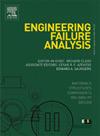Fatigue remaining life prediction of high pressure turbine casing with unacceptable defects
IF 4.4
2区 工程技术
Q1 ENGINEERING, MECHANICAL
引用次数: 0
Abstract
Remaining life of a high-pressure turbine (HPT) casing of aircraft turbofan engine with cracks was determined. Cracks were detected during regular inspection and found out to be initiated by scratches made by non-skilled use of Electrical Discharge Machining (EDM). In total, 9 visible surface marks were made. Keeping in mind that this component is not repairable, and its replacement might be time-consuming and/or too expensive, it was essential to evaluate the remaining life and prevent failure if this component was to be used with cracks. Toward this aim, numerical methods had to be used, since testing of samples or component itself was not possible due to geometry restrictions. To get a reliable estimation of the remaining life, it was necessary to evaluate Paris coefficients C and m. Use of available data for fatigue crack growth was not an option, since coefficients are determined for virgin material and could not provide acceptable predictions for the used material. To overcome these difficulties, an innovative technique in two steps, based on finite element method, has been introduced. First step was to simulate fatigue crack growth. Then, response surface optimization (RSO) was used to obtain Paris’ coefficients that predict accurately the number of loading cycles to reach detected crack lengths, provided by the maintenance, repair, and operations (MRO) company’s workshop. Coefficients C and m, determined in this way, were then used to evaluate remaining life of the HPT casing and estimate the risk of its further use.
存在不可接受缺陷的高压涡轮机机壳的疲劳剩余寿命预测
对存在裂纹的飞机涡轮风扇发动机高压涡轮(HPT)外壳的剩余寿命进行了测定。裂纹是在定期检查过程中发现的,其起因是非熟练使用放电加工(EDM)造成的划痕。总共有 9 处可见的表面痕迹。考虑到该部件无法修复,更换可能会耗费大量时间和(或)成本过高,因此必须评估其剩余寿命,并在该部件出现裂纹的情况下防止其失效。为了实现这一目标,必须使用数值方法,因为由于几何形状的限制,不可能对样品或部件本身进行测试。为了可靠地估算剩余寿命,有必要对巴黎系数 C 和 m 进行评估。使用现有的疲劳裂纹增长数据是不可行的,因为这些系数是针对原始材料确定的,无法为使用过的材料提供可接受的预测。为了克服这些困难,我们采用了一种基于有限元法的创新技术,分为两个步骤。第一步是模拟疲劳裂纹的生长。然后,利用响应面优化(RSO)获得帕里斯系数,从而准确预测达到检测到的裂纹长度所需的加载循环次数(由维护、维修和运营(MRO)公司车间提供)。通过这种方法确定的系数 C 和 m 用于评估 HPT 套管的剩余寿命,并估算其继续使用的风险。
本文章由计算机程序翻译,如有差异,请以英文原文为准。
求助全文
约1分钟内获得全文
求助全文
来源期刊

Engineering Failure Analysis
工程技术-材料科学:表征与测试
CiteScore
7.70
自引率
20.00%
发文量
956
审稿时长
47 days
期刊介绍:
Engineering Failure Analysis publishes research papers describing the analysis of engineering failures and related studies.
Papers relating to the structure, properties and behaviour of engineering materials are encouraged, particularly those which also involve the detailed application of materials parameters to problems in engineering structures, components and design. In addition to the area of materials engineering, the interacting fields of mechanical, manufacturing, aeronautical, civil, chemical, corrosion and design engineering are considered relevant. Activity should be directed at analysing engineering failures and carrying out research to help reduce the incidences of failures and to extend the operating horizons of engineering materials.
Emphasis is placed on the mechanical properties of materials and their behaviour when influenced by structure, process and environment. Metallic, polymeric, ceramic and natural materials are all included and the application of these materials to real engineering situations should be emphasised. The use of a case-study based approach is also encouraged.
Engineering Failure Analysis provides essential reference material and critical feedback into the design process thereby contributing to the prevention of engineering failures in the future. All submissions will be subject to peer review from leading experts in the field.
 求助内容:
求助内容: 应助结果提醒方式:
应助结果提醒方式:


